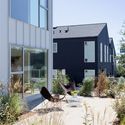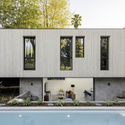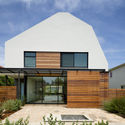
Los Angeles is a city of dreams. Known across the United States and the world, L.A. embodies both freedom and experimentation, defined as much by its freeways as its diversity. It is also a city of houses. Single-family homes cover almost half of Los Angeles, and as the city continues to evolve, architects have explored new ideas on modernity and daily life through the single-family typology.
Around 10 million people live in L.A. County, and Los Angeles itself has become one of the world's most ethnically diverse cities. The built environment reflects the nature of its residents, home to some of the most iconic residential and cultural architecture in the world. Los Angeles has its own dose of Lautner, Schindler, Wright, and Neutra. It's a city that has long embodied multiplicity and progressive forms, from the Eames House and Gehry's Residence to the iconic Stahl House. Through the lens of photographer Julius Shulman, many homes came to represent not only new residential styles but also the postwar culture of Southern California.

But L.A.'s architectural identity is also fluid, shaped by planning, economic and social forces that define how people live today. Going beyond the historic homes of Los Angeles, the following projects showcase single-family residential design over the last decade. Building off a legacy rooted in many predecessors and the Case Study House program, these recent projects also deal with a range of zoning and economic factors that are changing how homes can be designed. No other city is home to so many influential modern houses, and at the same time, L.A. is facing issues of density and a housing shortage that will redefine the single-family home once again.
Bridge House LA by Dan Brunn Architecture

Located in the heart of Hancock Park, Bridge House LA was completed over 2 years. Designed by Dan Brunn, the home literally bridges 65’ over a natural stream. Staying consistent with Brunn’s “less is more” approach to building, the home occupies 4,500 square feet on a 15,000 square-foot lot. The project’s commitment to sustainable solutions aims to serve as a demonstration of innovative systems and forward-thinking processes. “The idea is to do something extraordinary with ordinary means”, said Brunn.
Blackbirds by Bestor Architecture

While technically a collection of single-family homes, Blackbirds is a cluster of 18 homes nestled in the bohemian hills of Los Angeles’ Echo Park neighborhood designed by Bestor Architecture. The multi-house development is a progressive design solution for high-quality dense housing in a city with little available land. The houses are 1,930 square feet or less, are a mix of two and three bedrooms, and are built around a living street: a central courtyard that comprises both landscape and parking areas, as well as serving as the stage for larger community functions and play.
Yin-Yang House by Brooks + Scarpa Architects

The Yin-Yang House is a single-family home in a quiet Venice neighborhood. The design objective was to create a space for a large and growing family with several children, which would create a calm, relaxed and organized environment that emphasizes public family space. The home is also meant to serve as a place to entertain and a welcoming space for teenagers to socialize with friends.
Tree Top Residence by Belzberg Architects

The Tree Top Residence celebrates the site’s complex landscape, emerging from atop the canopy of trees that surround it. Built along a natural ridge line, the long and narrow plan of the three-story house mimics and inverts the angles of the site’s topography, creating both vertical and horizontal relationships. Vertically, a helical stair functions as a primary organizing element and a sculptural gesture upon entry into the house. On the ground floor, it acts as a threshold into the open plan; on the floor above, it separates the master suite and children’s quarter, while providing a light well to the basement. Horizontally, walls are used sparingly in favor of fluidly connected spaces.
Car Park House by Anonymous Architects

Starting with a vacant lot with a very steep downslope from the street, the design of the Car Park House places the carport on the roof with the residence below. In addition to shifting expectations, it is also a response to the building code which requires parking for two vehicles. This inversion moves the typical ground floor of the house up on the roof and makes the act of arriving home and driving onto the roof of the house a surprise. The roof is also usable as deck space and has unobstructed views of the San Gabriel Mountains.
Pittman Dowell Residence by Michael Maltzan Architecture

Located 15 miles north of Los Angeles at the edge of Angeles National Forest, the Pittman Dowell Residence is sited on 6 acres of land originally planned as a hillside subdivision designed by Richard Neutra. As Michael Maltzan Architecture explains, only one house, the 1952 Serulnic Residence, was built on the site. Over the years the current owners have developed an extensive desert garden and outdoor pavilion on unbuilt pads. The new Pittman Dowell Residence sits on the last clearing, circumscribed by the sole winding road which leads to the Serulnic Residence on the bluff above.
30th Street House by Blue Truck Studio

The 30th Street House was designed to reimagine a home with existing octagon-shaped rooms and triangular spaces. The client asked for a home of simple forms and rustic textures, like the ones in the Northern California community of Sea Ranch. On the exterior, Blue Truck Studio reconfigured windows and added siding, wrapping it around the house to simplify its form and provide privacy. The custom-milled siding is Alaskan yellow cedar and was chosen specifically for how it will weather over time, graying out to create a rustic patina reminiscent of the Sea Ranch aesthetic.
Orum Residence by SPF: architects

Orum Residence was designed to create a home that could meld into its surroundings while maximizing views. The three-story structure, which takes on the shape of a three-winged propeller, is wrapped in glass that mirrors its sweeping views of the Los Angeles Basin, which are unobstructed from the Getty Center to Long Beach, Century City, and Downtown. The client wanted a luxurious house where she could throw large events and host her extended family. To make this work, the team distributed the program across three ‘blades’ that radiate from a central node.
See-Through House by Koning Eizenberg Architecture

Koning Eizenberg designed the suburban See-Through House for a Planning Commissioner and her family. The project was made to offer a relaxed connection to the street and provide an amplified perception of space on a typical 50’x 150’ lot by organizing expansive views through the length of the house. As the team explains, a barn-shaped roof emerged from tracing the maximum permitted planning envelope, producing a rural reference that fitted both the family’s background and their interest in the informal, modest and communal. A Quaker bonnet, seen in an old family portrait, inspired the shaping of the guesthouse roof, which backdrops the series of indoor and outdoor spaces. Movable privacy/sun control screens between the house and yard modify views inside and out at different times of the day.
Hill House by Johnston Marklee

Completed in October 2004, the Hill House was designed to address a range of site conditions on a hillside. Located in Pacific Palisades, California, while the site for the house offers panoramic views from Rustic and Sullivan Canyons to Santa Monica Bay, the irregularly shaped lot is situated on an uneven, downhill slope. With the canonical Eames House nearby, the 3300 square foot Hill House provocatively continues the Case Study House tradition of experimentation and reinvention of Los Angeles lifestyles. The massing of the Hill House was driven by two criteria: to maximize the volume allowed by the zoning requirements, and to minimize contact with the natural terrain.
Editor's Note: This article was originally published on December 10, 2019.



















